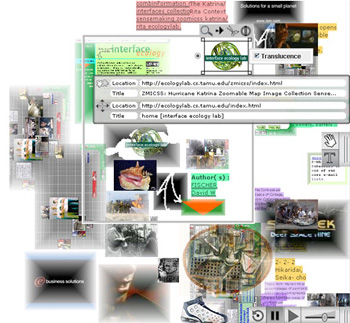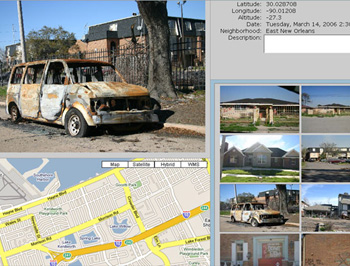Related Categories: Browser Innovations | Tools for Online Reading | Search & Data Mining Innovations | Alternative Interfaces | Text Visualization | Text and Multimedia
Original Objects for Study descriptions: CollageMachine/combinFormation | ZooMICSS
Summary:
Interface ecology is a theoretical framework for the study of relationships between interfaces; its objects range from social to computer interfaces. The practice of interface ecology is characterized by three intertwined objectives: the analysis of interfaces as cultural artifacts from an ecosystems approach, the production of systems and interfaces that elevate the role of human expression, and the translation between disparate cultures and disciplines. This approach was first theorized by Andruid Kerne through his own interdisciplinary work in performance art and computer science at New York University (1997-2001). He has published on interface ecology primarily within computer science and digital art forums from this period to the present. Five years ago, Kerne established the Interface Ecology Lab at Texas A&M University.
Description:
Interface ecology defines the interface both as the physical layer between human and machine and, in the broader sense, as the places where people, cultures, and concepts meet. Instantiating an ecosystems approach, interface ecology focuses its attention on the dynamic interactions, relationships, and flows between these heterogeneous groups of elements, studying how they constitute an ecological system. These interactions take a variety of forms, and, correspondingly, the interface takes a variety of functions: “a means of contact, a border zone, a layer hosting exchange, a nexus where resources–such as information–and power are circulated and transformed, and a channel through which interactors communicate.” [1] The practice of interface ecology involves analyzing sets of interface functions in a given system, as well as tracing different cultural and technical trends across these interfaces.
Interface as Border
One emergent mode of the ecosystems approach is the study of the interface as a border zone where particular interactions are prohibited and relationships are cut short. Andruid Kerne writes:
The borders might lie between divisions, corporations, ethnic groups, or nation-states. They enable some kinds of exchange; they form barriers to others. Different languages are spoken, different cultures play on different sides. Part of the job is to become fluent in these. The ecologizer working between worlds needs to understand their systems of representation—their semiotic building blocks, codes, configurations, and dynamics.[2]
The study of the interface as a border zone involves analysis of the basic theoretical assumptions, materiality, and structures of knowledge that underlie the entities on either side of the interface, and the places where they are incommensurable. This approach has much in common with cultural studies approaches that focus on in-between spaces, diasporic experiences, and hybridity.
Sensation
Interface ecology entails an attention to sensation and cognition, as our bodies are the core of the user experience. Kerne writes, “Through the process of sensation, through perception and action connected, at the nexus of the interface, I encounter all of these systems of representation, their forms as media, the rules that govern their production and the subversions that attempt to countervail, the underlying epistemologies, and their methodologies of practice.”[3] Interface ecology does not allow for a distant observer who maps out the ecosystem. Rather, it demands that the ecologist conceptualize herself as a sensing being in relation to the interface and locate herself as a translator and an interface between objects. This approach draws from critical ethnography, where writers are forced to make themselves explicit in their work. While “studies” approaches, for example “performance studies,” tend to distance themselves from the object under study, the theoretical analysis of interfaces is situated as part of the same ecosystem as creating and producing.
Theory and Practice
Interface ecology is also characterized by the meshing of theory and practice: theoretical articulations go hand in hand with the production of new systems and interfaces. Kerne writes in his dissertation that interface ecology involves mixing: “it is creating new semiotic constellations built with influences and elements from both sides of a border.”[4]
Kerne’s CollageMachine, part of his dissertation project at NYU, draws two methods from John Cage–indeterminacy and found objects–into the context of the web. Users explore a recombinant information space, where different web elements surface, blend, and adapt to their browsing. The program automatically seeks out and imports media elements of interest and continuously streams these elements into the user’s field of view. Thus, the user is able to locate information and to generate conceptual links that may not have been possible with a traditional web browser. Kerne situates CollageMachine as an example of the genre of Web-recombiners, other instances of which he cites as Mandala (Helfman and Hollan: 2001), Shredder (Napier: 1998), Netomat (Wisniewski: 1999), and Impermanence Agent (Wardrip-Fruin: 1999).
CollageMachine has been further developed in the Interface Ecology Lab as combinFormation (Figure 1). The project has been shown at SIGGRAPH and presented at a variety of other arts and engineering conferences. It can currently be explored on the interface ecology website: http://ecologylab.cs.tamu.edu/combinFormation/index.html.
Another project developed at the Interface Ecology Lab is the Zoomable Map Image Collection Sensemaking System (ZooMICSS): The Katrina/Rita Context. This project enacts Participant Action Research (the development of technology with rather than for the New Orleans community) and visualizes user photos of the Hurricane Katrina’s aftermath (Figure 2). The project was conceived in response to the drastic growth of locative multimedia: as Graeber, et. al. write: “As the size and number of these… media collections grow, so too does the importance of systems that support collection sensemaking.”[5] The photographs are organized both geographically and according to different visual and semantic connections between them. Users of the ZooMICSS system are able to compare destruction and rebuilding across the city and to browse the images in a meaningful way. The creators conceptualize the project as a collective visual history and a tool for residents to retell the stories of the event.
Interface ecology based projects are characterized by the process of recombination: different systems are broken down to their elements and re-combined into arrangements under a new system of coding. Kerne writes that “recombinant information is a structural formula for creating new knowledge,” and thus, interface ecology systems, like its theories, are created to expand and problematize pre-existing knowledge.[6]
Meta-disciplinarity
Because interfaces, by nature, bring disparate actors and semiotic systems into contact, interface scholars will encounter a variety of disciplinary and cultural systems. In translating between them, recombination occurs: disciplines are re-coded in the terms of other disciplines and new knowledge is formed. The mode of interface ecology is necessarily “meta-disciplinary;” cultural and disciplinary recoding is inherent in its process.
Research Context:
Interface Ecology was developed by Andruid Kerne as part of his dissertation at NYU, where he lies out the fundamental tenets of the project. Kerne writes that intellectual roots of interface ecology include Richard Schechner’s environmental theater (a practice that extends “theater” in discipline, space, and time) and Gregory Bateson’s ecology of the mind. Since then, there have been a number of publications on interface ecology in computer science and arts forums and many new media projects have been constructed. Interface ecology, though practiced in a variety of spaces, has been based at the Interface Ecology Lab at Texas A & M University since 2001.
Interface Ecology, and the Interface Ecology Lab, is an example of the inter-/trans-/meta-disciplinary academic collaborations that are formed to address issues and problematics of digital media. Interface ecology draws upon such varied approaches as semiotics, phenomenology, cognitive science, cultural studies, and computer science. However, despite the fact that it draws upon a wide range of humanities scholars, Interface Ecology has been presented primarily in the arts and sciences, including ACM and SIGGRAPH.
Evaluation of Opportunities/Limitations for the Transliteracies Topic:
As an interdisciplinary project whose aim is to foster communication across departments and campuses in the University of California system, Transliteracies may be conceptualized as an interface between different systems of knowledge and representation. The humanities, social sciences and sciences are brought into contact through the nexus of online reading. The ecosystems approach is a conceptual framework for understanding this both as a space of interaction and as a border zone. The interface ecology project offers an example of this practice, but also offers a vocabulary through which Transliteracies might articulate some of its own interdisciplinary processes and goals.
In addition, interface ecology provides one method for the study of actual online interfaces in an interdisciplinary context. The Interface Ecology Lab’s projects are valuable reference points for understanding online experience and new reading interfaces as they are self-reflexive and conceptualized in relation to contemporary problematics of the interface.
One strength of Transliteracies has been its ability to bring together a variety of different new media objects. Interface ecology supplies one possible critical framework though which we might map the connections and disjunctures between these objects. Other potential critical frameworks might include media archaeology and genealogy.
Notes
- [1] Kerne, Andruid. “Interface Ecology: An Open Systems Approach to Analyzing and Making Culture.” Talk presented to the Conference on Performance Studies. Atlanta, March 1997.
- [2] Kerne, Andruid. “CollageMachine: A Model of ‘Interface Ecology.’” NYU Ph.D. Dissertation. April 2001, p. 18.
- [3] Kerne, Andruid. “Doing Interface Ecology: The Practice of Metadisciplinarity.” PROC SIGGRAPH 2005. Art and Animation, p.182.
- [4] Kerne, “CollageMachine: A Model of ‘Interface Ecology,’” p. 19.
- [5] Graeber, R., Kerne, A., Henderson, K., ZooMICSS: A Zoomable Map Image Collection Sensemaking System (the Katrina Rita context), Proc ACM Multimedia, Santa Barbara, Oct 2006.
- [6] Kerne, “Doing Interface Ecology: The Practice of Metadisciplinarity,” p.181.
Resources for Further Study:
- Interface Ecology Website: http://ecologylab.cs.tamu.edu/index.html. This is the best reference for further research; most of the Interface Ecology Lab’s work can be found on this site.
- Andruid Kerne’s home page
- Kerne, Andruid. “Doing Interface Ecology: The Practice of Metadisciplinarity.” Proc SIGGRAPH 2005. Art and Animation, 181-184.
- Kerne, Andruid. “Interface Ecosystem: the Fundamental Unit of Information Age Ecology.” Proc SIGGRAPH 2002. Art and Animation, 142-145.
- Kerne, Andruid. Interface Ecology: An Open Conceptual Space of Collage and Emergence, ArtLab23, Spring 2002:1, School of Visual Arts, NYC.
- Kerne, Andruid. “CollageMachine: A Model of ‘Interface Ecology.’” NYU Ph.D. Dissertation. April 2001.
- Kerne, Andruid. “Interface Ecology: An Open Systems Approach to Analyzing and Making Culture.” Talk presented to the Conference on Performance Studies. Atlanta, March 1997
The articles below are of particular relevance to the Transliteracies Project:


